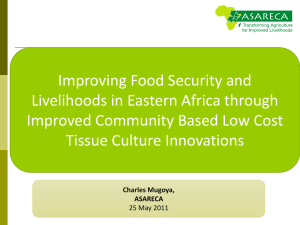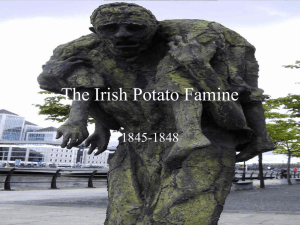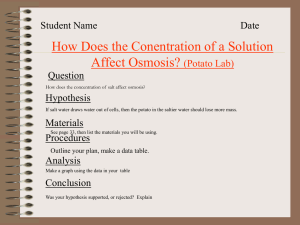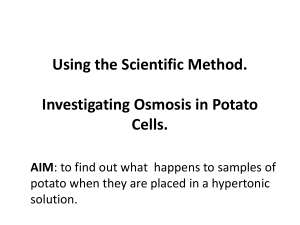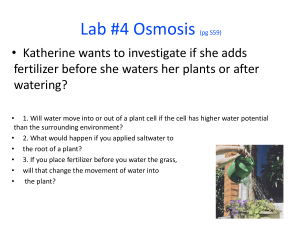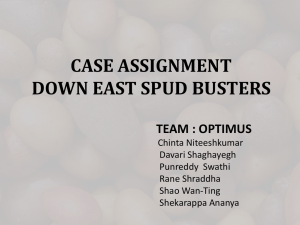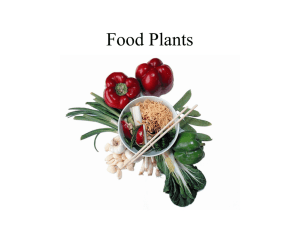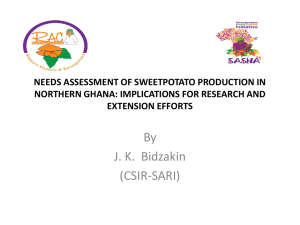Tuesday Lecture – Leaf and Stem Crops
advertisement
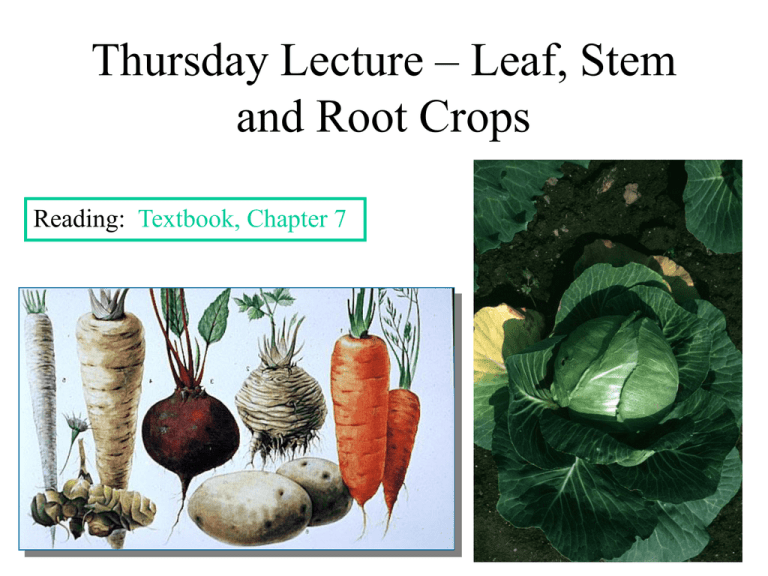
Thursday Lecture – Leaf, Stem and Root Crops Reading: Textbook, Chapter 7 Baby carrots – a product of the “Soccer Mom” age Baby carrots are produced by using specially bred forms that produce a long, thin storage root. The roots are carefully selected to eliminate discolored or malformed ones, and then are sliced into short pieces (2-3 inches). The pieces are further checked for color (they must have no hint of green) and are sent through a lathe device that smoothes the ends. The final product is ready to eat in a convenient form. Quiz Quiz 1. Name a vegetable for each category of what we actually eat: petiole: entire leaf: inflorescence: 2. Where was the potato domesticated? What part of the plant do we eat? Asparagus – Eat Your Lilies See Fig. 7.25, p. 177 Onions – Allium cepa See Fig. 7.27, p. 179 Leeks – Another Allium See Fig. 7.27, p. 179 Bulbs Succulent Storage Leaves Stem Adventitious Roots Big buds on short stems Corms: short fat underground stems Rhizomes: simple underground stems Hydrocotyle Petioles reach above the sand Nodes Adventitious Roots Apex of Rhizome Tubers: swollen ends of rhizomes Corm - Crocus STEMS Tuber - potato Bulb onion Irish Potato Solanum tuberosum The Amazing Spud - The potato is a short duration crop that produces a large amount of calories in a short period of time - The potato produces more protein and calories per unit area per unit time and per unit of water than any other major plant food. - The ratio of protein to calories, the quality of the protein and the high levels of vitamins and minerals are assets greatly needed in many countries. Potatoes – South American Staple Potatoes – South American Staple Potatoes – South American Staple Potatoes – South American Staple Potatoes Travel to Europe Frederick the Great encouraging peasants to grow more potatoes Potatoes Travel to Europe Frederick the Great encouraging peasants to grow more potatoes Potatoes Travel to Europe Frederick the Great encouraging peasants to grow more potatoes Vincent van Gogh painting: “The potato eaters” (Belgium) Potato Blight Healthy leaf Potato Blight Healthy leaf Potato Blight: Phytophthora infestans (fungus) Blighted leaf Potato Blight Healthy leaf Potato Blight: Phytophthora infestans (fungus) Potatoes damaged by blight Blighted leaf The Irish Potato Blight Ireland – potato became staple crop in 1800s The Irish Potato Blight Ireland – potato became staple crop in 1800s functionally monoculture – political & cultural considerations 1840s – potato blight hit: population 8 million 6 million The Irish Potato Blight Ireland – potato became staple crop in 1800s functionally monoculture – political & cultural considerations 1840s – potato blight hit: population 8 million 6 million - 1 million people died; 1.5 million people immigrated to Australia & U.S.A. Potato Culture – Increasing Mechanization Holland Potato Farms 100 years apart 1870 1970 Improving Potato Yields Despite appearances, not yet a priority for the Green Revolution Tropical Starchy Staples True Yam Dioscorea sp. Taro Colocasia esculenta Asia tropical Pacific Yautia Xanthosoma sp. South America Arrowroot Maranta sp. West Indies/South America Manioc Manihot esculenta South America Sweet Potato Ipomoea batatas Africa, Asia, South America South America Tropical Starchy Staples True Yam Dioscorea sp. Taro Colocasia esculenta Asia tropical Pacific Yautia Xanthosoma sp. South America Arrowroot Maranta sp. West Indies/South America Manioc Manihot esculenta South America Sweet Potato Ipomoea batatas Tubers Africa, Asia, South America South America Tropical Starchy Staples True Yam Dioscorea sp. Taro Colocasia esculenta Asia tropical Pacific Yautia Xanthosoma sp. South America Arrowroot Maranta sp. West Indies/South America Manioc Manihot esculenta South America Sweet Potato Ipomoea batatas Tubers Roots Africa, Asia, South America South America Yams – Another Tuber Dioscorea sp. Monocot vines – different species domesticated independently in various tropical areas Taro – Food from a Corm Taro – Food from a Corm Taro – Food from a Corm Starchy Root Crops – Manioc (Cassava) Cassava – Food for the “Poorest of the Poor” Staple food for >500 million people Cassava – Food for the “Poorest of the Poor” Staple food for >500 million people Cassava – Food for the “Poorest of the Poor” Staple food for >500 million people Most calories per unit area of land (except for sugar cane) Cassava – Food for the “Poorest of the Poor” Staple food for >500 million people Most calories per unit area of land (except for sugar cane) Grows in poor soils Cassava – Food for the “Poorest of the Poor” Staple food for >500 million people Most calories per unit area of land (except for sugar cane) Grows in poor soils Primarily carbohydrate – low in protein, minerals, vitamins Cassava – Food for the “Poorest of the Poor” Staple food for >500 million people Most calories per unit area of land (except for sugar cane) Grows in poor soils Primarily carbohydrate – low in protein, minerals, vitamins Cyanogenic glycosides must be removed before consumption Cassava – Food for the “Poorest of the Poor” Staple food for >500 million people Most calories per unit area of land (except for sugar cane) Grows in poor soils Primarily carbohydrate – low in protein, minerals, vitamins Cyanogenic glycosides must be removed before consumption Deteriorates rapidly after harvest (worthless after 48 hours) Cassava – Food for the “Poorest of the Poor” Staple food for >500 million people Most calories per unit area of land (except for sugar cane) Grows in poor soils Primarily carbohydrate – low in protein, minerals, vitamins Cyanogenic glycosides must be removed before consumption Deteriorates rapidly after harvest (worthless after 48 hours) Low tech crop no profit for large companies Starchy Root Crops – Sweet Potato Ipomoea batatas – Convolvulaceae (Morning Glory Family) Tuesday Lecture – Stem and Root Crops Reading: Textbook, Chapter 7

